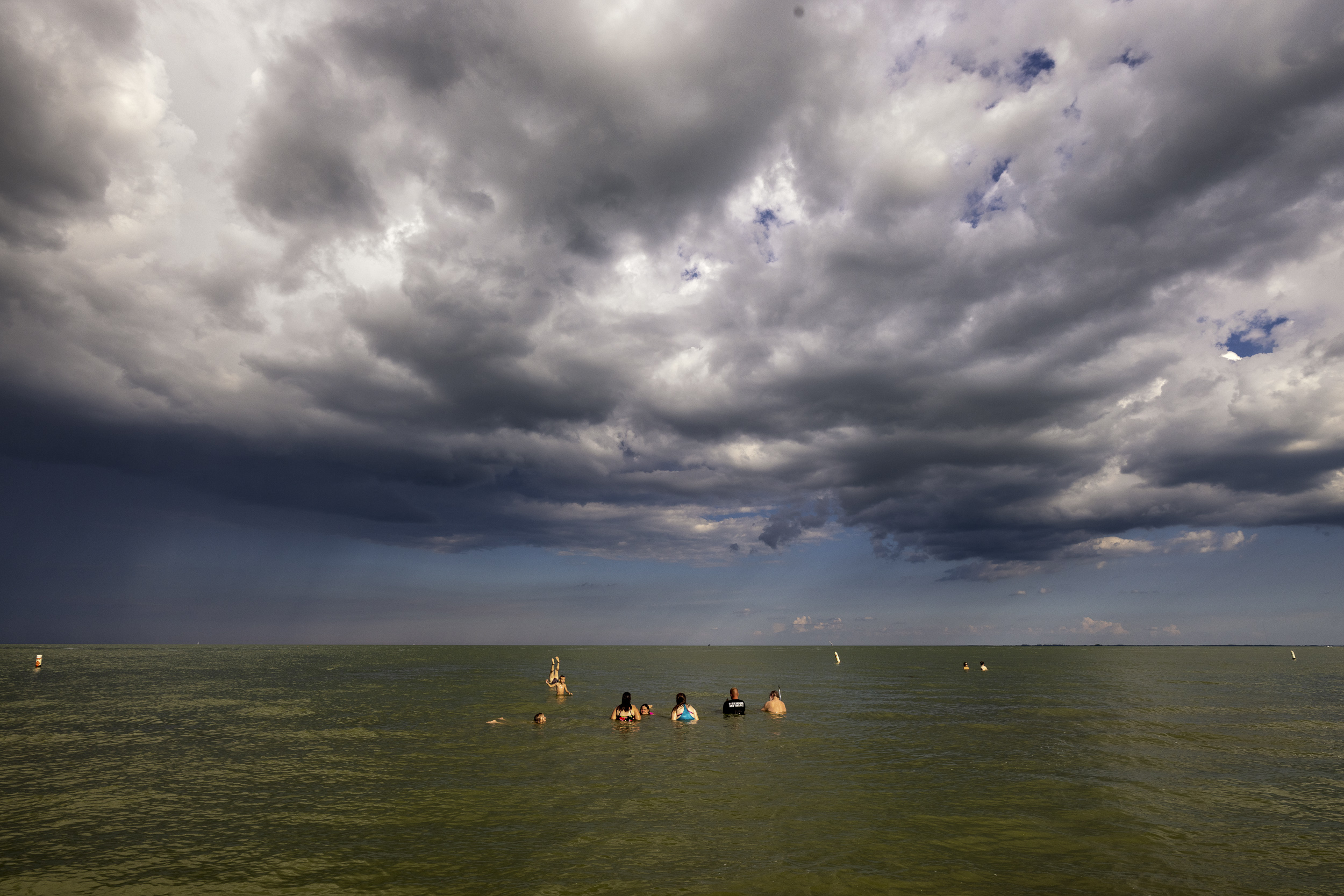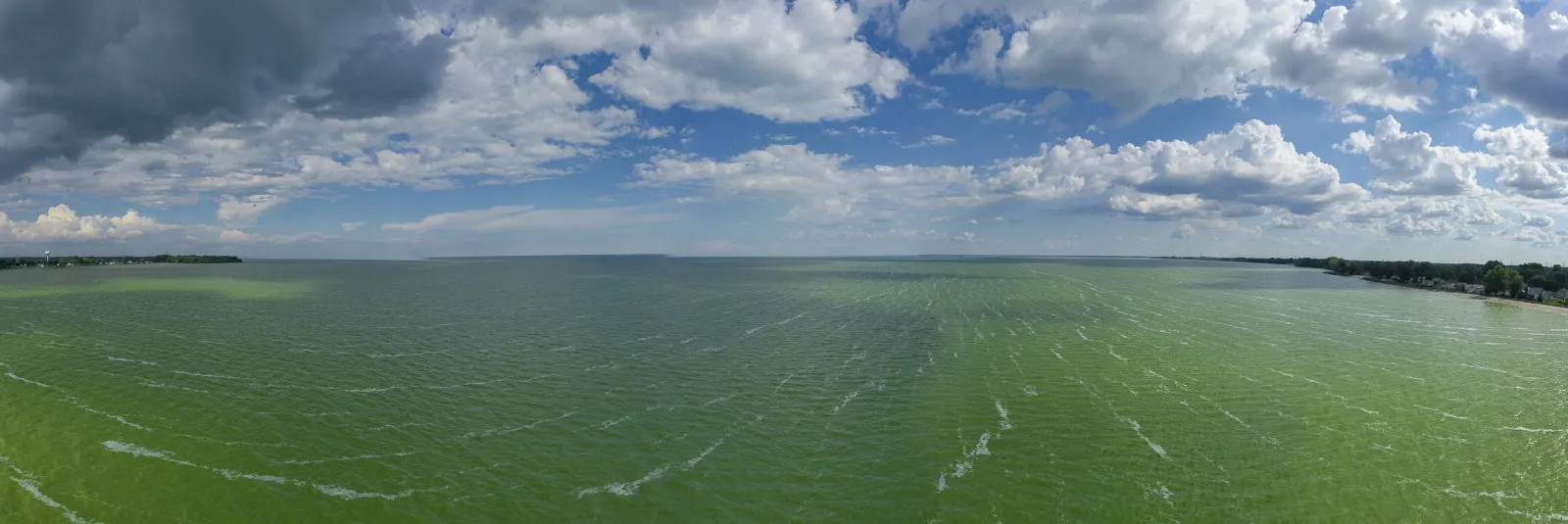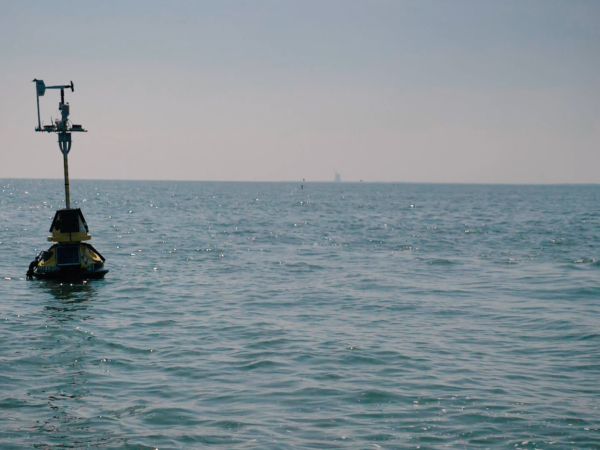
By Laura Gersony, Circle of Blue
The Great Lakes News Collaborative includes Bridge Michigan; Circle of Blue; Great Lakes Now at Detroit Public Television; and Michigan Radio, Michigan’s NPR News Leader; who work together to bring audiences news and information about the impact of climate change, pollution, and aging infrastructure on the Great Lakes and drinking water. This independent journalism is supported by the Charles Stewart Mott Foundation. Find all the work HERE.
Fourth of a six-part series
Every August, says Alicia Smith, the city of Toledo holds its breath.
Their collective trauma dates back to August 2, 2014, when she and half a million other Toledoans woke to alarming news: the water coming out of their taps was toxic.
Their drinking water contained microcystin, a toxin known to cause diarrhea, vomiting, and liver damage at small concentrations. Blindsided by the announcement, the poor, majority-Black neighborhood of Junction began a desperate scramble to keep everyone safe.
“There were families who did not know about it, because they were living without electricity, so they didn’t hear the story,” Smith recalls. “There were elders who couldn’t take their medication. Children who could not bathe.”
Toledo’s water emergency was the product of an ecological hazard that Smith and her neighbors had no hand in creating. Every year, Lake Erie’s western basin turns a murky shade of green from toxic, nutrient-stoked harmful algae blooms. The expansion of industrial-scale farming in the basin, plus rainstorms made worse by climate change, have caused the blooms to surge in recent years.
By and large, the Lake Erie basin’s attempts to curb the pollution at its source have failed. Despite billions of dollars invested in voluntary fertilizer-reduction efforts, the contamination that feeds the blooms has not diminished. Some interventions are making the problem worse.
“Goodness, there was plenty of attention when the water sector shut down,” Wade Kapszukiewicz, Toledo’s mayor, said in an interview with Circle of Blue. “But there’s been no progress. I believe that the key moment here will be when the politicians in Columbus begin to see this as an economic issue and not just an environmental or health issue. They’ve pretty clearly shown that they just don’t care about the environmental and health implications. They’ve had a chance to deal with it. They chose instead to ignore it.”
The consequence is that the cost of runaway agricultural pollution is falling on shoreline communities like Toledo. In this city, toxic algae blooms hike water bills by $100 per year for a family of five.
Every bloom event slices tens of millions of dollars off of the local economy and property values. It exacts a psychological toll on residents living next to polluted waterways. And it’s making already-disadvantaged communities question just how much they can trust their elected officials.

Subsurface tile networks drain almost every acre of farmland in eastern Michigan from Saginaw Bay to Lake Erie. Their outlets are a primary source of dissolved phosphorus contaminating state waters. Photo © J. Carl Ganter/ Circle of Blue
“There’s still no mandate that says, ‘farmers have to fix this or there will be penalties.’ But there’s penalties to residents. And there’s penalties to utility payers,” said Smith, a community organizer in Junction. “How can we trust people who are making deals with farmers, without also making mandates to protect us?”
Residents feel these penalties most acutely in their water bills. First, cleaning up toxic algae requires new equipment. According to a survey of public water systems by the Ohio EPA, obtained by the Alliance for the Great Lakes, the systems in the algae-afflicted West Lake Erie Basin have spent an average of $14 million on facility upgrades to deal with the blooms. After the 2014 shutdown Toledo spent $53 million to install an ozone treatment system at the city’s drinking water plant to safeguard customers from algal toxins, said Andrew McClure, the plant’s administrator.
Then there is the ongoing cost of putting that equipment to work. Algae makes water treatment more expensive at every step of the way. On average, monitoring the lake for toxins costs Western Lake Erie treatment plants about $21 million per year. Mitigating those blooms costs another $21 million. Filtering out algae-related toxins costs $220 million. And special measures to dispose of the toxic waste product costs $220 million, though not all of those costs are strictly related to algae.
These expenses trickle down into residents’ water bills. On average, the Alliance for the Great Lakes study found, the cost of cleaning up algae blooms across the state of Ohio amounts to $10 per resident per year. In Toledo, this figure is higher: $19 per resident, or about $100 per year for a family of five.
Compared to the multi-million dollar scale of the problem, that might not sound like much. But this is a city where 20 percent of residents report “often” or “always” reducing their spending on basic needs to afford their water bill. Water rates more than doubled between 2010 and 2020, while income of the city’s poorest one-fifth of residents inched up only 12 percent. This group now spends more than a quarter of their income on their water bill alone.
Affordability advocates say these trends are exacerbated by income-blind rate structures which have urban ratepayers buy water at the retail price, while wealthier suburban water suppliers pay the discounted wholesale price—the subject of an ongoing feud between Toledo and its suburbs. The algae blooms deal yet another blow to the city’s most vulnerable residents.
“It really does come down to the fact that poor people, that have the least ability to pay, are the ones who are forced to come up with the dollars to upgrade their infrastructure, but the problem is coming from external forces,” says Nick Schroeck, the former director of the Great Lakes Environmental Law Center.
The effects of toxic blooms don’t stop at water treatment plants. They ripple out into the local economy. When the unsightly, foul-smelling blooms hit, fishing permit sales drop by 10 percent. Property values take a hit. Boating businesses migrate eastward, and kayaking companies see waves of mass cancellations. Fishing guides have grown accustomed to an annual cough, consistent with health warnings.
After the 2014 Toledo water crisis, the binational International Joint Commission tried to put a price tag on the event. The resulting study placed this figure at about $65 million: the bloom lopped about $20 million dollars off of tourism, recreation, and the local housing stock, plus $4 million for water treatment.
Climate change promises to raise all of these costs. Climate models predict with near unanimity that more atmospheric warming will increase annual rainfall in Michigan and Ohio: a trend that is already making algae blooms worse. If severe blooms repeat year after year, the price tag rises to $1 billion over a decade.
It’s evidence that addressing the blooms is a matter of climate justice, says Sanjiv Sinha, the author of the IJC-commissioned economic impact report.
“Climate change events, and its related impact on nutrient runoff, are not fair in their impacts. They disproportionately impact people that financially are at the bottom of society,” said Sinha, senior vice president of the research group Environmental Consulting & Technology.
“We don’t know what the future holds when it comes to weather patterns except that longer term, consistent prediction is far more complicated. So we especially need to look out for folks that are on the lower end of the financial ladder in our society even more.”

Michigan’s extensive drainage infrastructure carries nutrient-rich water from 3.8 million acres of farmland and directs it into streams, rivers, and canals that terminate in the Great Lakes. Photos © J. Carl Ganter/ Circle of Blue
Algae Democracy
On the ground in Toledo, the day-to-day reality of living near a toxic waterway is one of cumulative stress and heightened vigilance. Smith has friends in Toledo who live along the Maumee River, the main artery of nutrient pollution into Lake Erie, where green slime coats the rocks on the river’s edge. Often they are wary of their own backyards.
“It’s no small thing to make the eleventh-largest lake go toxic every summer,” says Mike Ferner, founder of the citizen group Lake Erie Advocates, who lives along the lake shoreline.
As in communities across the country, environmental health is a proxy for the city’s longer struggle with disinvestment. In Junction, much of the neighborhood’s economic energy has been spent getting out from under the thumb of systemic racism. Between the discriminatory practice of redlining, which made African-American neighborhoods like Junction ineligible for government-backed mortgage loans through the 1960s, its fair share of white flight, and its industrial workforce in steady decline since the 1970s, money has been fleeing the city for much of the 20th century.
And political power with it. Smith views the toxic algae blooms not just as an environmental problem, but a part of the city’s decades-long struggle to gain a voice in American democracy. “Whoever controls the water controls everything,” Smith said.
She’s not the only one with this philosophy.
“I completely agree with everything my mom said,” says Alexis Smith, daughter of Alicia, in conversation with Circle of Blue.
Alexis Smith grew up watching her mom work at Junction Coalition, a Toledo-based civic group dedicated to improving the neighborhood. Now, she is a staffer at Freshwater Future, a Michigan-based grantmaking group that supports water quality and affordability efforts in the Great Lakes region. In a joint interview with Circle of Blue, mother and daughter often nodded passionately as the other was speaking, and seconded each other’s remarks.
The two Smiths stand as a testament to the fact that advocating for water free of toxic algae is now a multigenerational issue. In their eyes, Toledo has had to fight for basic environmental health and safety: something that richer communities take for granted.
“We ask for these regulations, and protections of the water, because we know that having these blooms in the lake will cause downstream harm on these already-suffering and already-disinvested communities,” said the younger Smith.
She grows exasperated discussing how the blooms — a situation her mother believes should be classified as a public health emergency — could have been solved long ago. Attending an international water health roundtable in Detroit, Smith claims that her stories surprised the delegation from Africa.
“They heard the stories of us here in Toledo, Flint, and Benton Harbor, and they were shocked. They were like, ‘you guys are supposedly a developed country,’” she said. “That these issues still persist today is absolutely mind-blowing.”

There’s no mandate that says farmers have to fix the source pollution that causes blooms or there will be penalties. But there’s penalties to residents. The cost of treating algae blooms trickle down into residents’ water bills. Photo © J. Carl Ganter/ Circle of Blue
The Lake Erie Bill of Rights
That hasn’t been for lack of effort. Just lack of political capital. Citizens advocating for a “polluter pays” model have as their enemy some of the most powerful lobbying groups in the region, including the Ohio Farm Bureau, whose spending reaches into the hundreds of thousands of dollars per election cycle, and multinational oil companies with fracking interests in the state.
Likewise, the slow-moving administrative state has stymied local activists again and again. The Clean Water Act is a clunky instrument for addressing diffuse pollution. It took a federal lawsuit for the EPA to designate Lake Erie as impaired. The resulting assessment, even as it concludes that Lake Erie is over-polluted, will not have teeth to enforce any nutrient reductions until policymakers say so.
So in 2019, the city of Toledo pulled a hail mary: they made Lake Erie into a legal person and proposed to protect her with “irrevocable rights” to “exist, flourish and naturally evolve,” reads the Lake Erie Bill of Rights, known among its supporters as LEBOR (“LEE-bore”).
Markie Miller, the main organizer behind the bill, began the effort after the 2014 water crisis. In the wake of the emergency, citizen panic had turned to anger and urgency.
“We thought, ‘Wait a minute, the city’s been monitoring the situation? Why are people hearing about it for the first time?’” Miller said. “It felt unlikely that we were going to succeed going though systems that had already been in place. [The crisis] happened on their watch. We needed something different.’”
LEBOR was always a long shot. On paper, LEBOR was intended to give rights to Lake Erie. But as a legal document, it would have shifted leverage to protect those rights to individual citizens. Ordinarily, individual citizens have no legal standing to sue unless they can causally link a direct injury to a single polluter. LEBOR was engineered as a response to this collective action problem.
While previous efforts to give legal personhood to natural resources have sprung up around the world, from Bangladesh to Bolivia, so-called “rights of nature” laws are few and far between in the U.S., and they have largely failed outside of tribal courts. Even its community champions knew that.
Nonetheless, when the LEBOR special election was held in February 2019, 60 percent of Toledons voted their approval despite an opposition campaign backed by the Texas-based oil company, BP North America. The victory was short-lived. A farm operation successfully sued to stop LEBOR’s enforcement the day after the election.
“The whole point was to be challenging. It was our way of confronting those laws and those systems. That was very intentional, because we want things done differently,” Miller said.
It came as little surprise when, in 2020, the bill was struck down in federal court for being overly vague. The bill’s standards “may trap the innocent by not providing fair warning,” the decision read, and “invite arbitrary enforcement by prosecutors, judges and juries.”
As a material game-changer, LEBOR was a failure. But it represented the hope and frustration of a community for whom all other means of advocacy had failed. For Miller and LEBOR supporters, it was a meaningful, if utterly fleeting, moment of empowerment.
“It had major legal issues, but conceptually it was a good idea,” said Schroeck, the environmental lawyer. “It’s the kind of creative thinking needed to solve the problem.”
Indeed, with LEBOR long gone, that is the question once again facing the people on the front lines of the algae blooms: how to flip the leverage back to citizens. The question has less to do with the environment, and more to do with political power, and its bearing on the age-old question of who pays the cost of pollution. Having experienced the damages on the front lines, the two Smith women believe that a solution must start with giving frontline communities a seat at the table.
“The majority can no longer be the majority of individuals who have a voice. It has to be the majority for what is fair, just, and doable,” says Alicia Smith. “That is what the Lake Erie Bill of Rights was asking for: a just engagement for all people.”
Catch more news at Great Lakes Now:
In A Year of Water Quality Reckoning, National Imperative is Impeded
Farms in Six Southeast Michigan Counties Are Major Sources of Lake Erie Toxic Blooms
Danger Looms Where Toxic Algae Blooms
Featured image: Photo © J. Carl Ganter/ Circle of Blue




